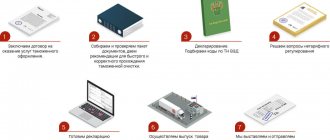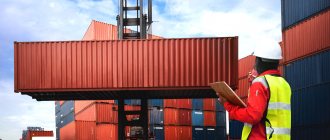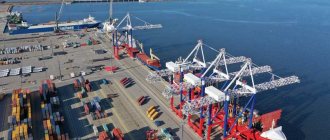Every day, thousands of sellers and ordinary citizens transport various objects across the border. If the requirements for individuals are minimal, and the border service is relatively loyal to such travelers, then they are quite strict towards participants in foreign economic activity, transport companies, and carriers. A legal entity must not only be registered, but also be required to provide a list of documents, which will become a kind of permission to travel further across the country with the possibility of subsequent resale of products. However, inspections become a difficult test for some, studying mistakes in practice, which in the future negatively affects the financial component. In the article we will consider in detail the description of the concept of “customs declaration of goods”, namely what it is, what forms exist and how to declare things correctly in order to avoid fines and delays.
Specifics of border control
Clearance of various cargo shipments at customs is a list of manipulations associated with the placement of transport and cargo under a special inspection regime corresponding to the provisions of the Labor Code. The procedure itself is recognized as one of the most important in relation to products transported across the state border. It consists of providing complete and accurate information about the products that are included in the declaration. All data must fully describe the product, purpose, quantity, weight, as well as many other characteristics.
Problems to be solved:
- presentation of data on objects, vehicles that are required for customs to achieve its goals;
- recognition of the legitimacy of the manipulations performed by the declarant;
- control of information and verification of compliance with the real state;
- maintaining customs (foreign trade) statistics, etc.
The algorithm involves submitting an application for consideration listing all information about the contents of the boxes, the vehicle and the selected registration mode. If necessary, other additional data may be requested, but their provision is necessary only if the request is justified.
Purposes of customs clearance
The information contained in the declarations can be used by FCS employees for:
- Combating smuggling or other violations of the law.
- Administrative regulation of foreign trade activities. organization of other types of state control (phytosanitary, veterinary, radioactive, environmental, etc.).
- Maintaining statistics.
How customs control is carried out when declaring goods
Carrying out customs control activities is a series of actions performed by supervisory authorities as part of their professional activities. The main goal is to ensure compliance with the law by all participants in foreign trade activities. At the same time, the concept of implementation of legislation refers not only to regulatory legal acts of the Russian Federation, but also international ones, as well as contracts between different states.
This type of control is carried out in a special territory of the country, within which it is possible to control the movement of property. At the same time, security officers carefully monitor that all participants in international cargo transportation fully comply with current legislative norms.
Among the main tasks of government agencies are:
- checking for compliance with legal regulations;
- implementation of legislation;
- following the norms and algorithm of border control.
Forms of control:
- Oral survey.
- Familiarization with documents.
- Check by special agency.
- Supervision within the “point”.
- Receiving explanations.
- Personal and property inspection.
- Checking identification characters.
- Accounting for imported and exported items and vehicles.
- Inspection of warehouse premises and surrounding areas.
Registration of the declaration is a separate point of control, which is its integral and completely irreplaceable part. Without it, it is impossible to import and export products. The end of all activities occurs only as they cross the border of a particular state, and often participants may encounter delays or delays in the implementation of state control along the way, which can subsequently become financial risks for customer companies.
Responsibility
The Tax Code establishes sanctions for violating tax legislation or evading compliance with them. Thus, Article 119 of the Code provides for punishment for failure to submit a declaration - a fine. Its value is 5% of the amount of unpaid tax. The calculation is carried out for each month from the date when the payer was supposed to provide reports. However, the total amount of collection cannot exceed 30% of the tax amount. The minimum fine is 1,000 rubles.
Ready-made solutions for all areas
Stores
Mobility, accuracy and speed of counting goods on the sales floor and in the warehouse will allow you not to lose days of sales during inventory and when receiving goods.
To learn more
Warehouses
Speed up your warehouse employees' work with mobile automation. Eliminate errors in receiving, shipping, inventory and movement of goods forever.
To learn more
Marking
Mandatory labeling of goods is an opportunity for each organization to 100% exclude the acceptance of counterfeit goods into its warehouse and track the supply chain from the manufacturer.
To learn more
E-commerce
Speed, accuracy of acceptance and shipment of goods in the warehouse is the cornerstone in the E-commerce business. Start using modern, more efficient mobile tools.
To learn more
Institutions
Increase the accuracy of accounting for the organization’s property, the level of control over the safety and movement of each item. Mobile accounting will reduce the likelihood of theft and natural losses.
To learn more
Production
Increase the efficiency of your manufacturing enterprise by introducing mobile automation for inventory accounting.
To learn more
RFID
The first ready-made solution in Russia for tracking goods using RFID tags at each stage of the supply chain.
To learn more
EGAIS
Eliminate errors in comparing and reading excise duty stamps for alcoholic beverages using mobile accounting tools.
To learn more
Certification for partners
Obtaining certified Cleverence partner status will allow your company to reach a new level of problem solving at your clients’ enterprises.
To learn more
Inventory
Use modern mobile tools to carry out product inventory. Increase the speed and accuracy of your business process.
To learn more
Mobile automation
Use modern mobile tools to account for goods and fixed assets in your enterprise. Completely abandon accounting “on paper”.
Learn more Show all automation solutions
What are the forms and terms of the procedure for customs declaration of goods?
To date, several options have been installed:
- oral – that is, all information is transmitted to employees orally. This method is acceptable for individuals when transporting non-commercial cargo, that is, personal luggage. The “Green Corridor” greatly simplifies inspection and all manipulations carried out;
- electronic - transfer of information through modern means of communication. For certification, an electronic signature is required, and verification is carried out by a special information system on average 3 hours after the referral. Not used by individuals;
- written information is required for items on the special list.
Types of customs declaration of goods
There are two classifications that are used today.
Nature of the procedure:
- incomplete - that is, information is provided partially, which is permitted for products for import or export. It is used in situations where the entire volume of information cannot be listed for certain reasons beyond the control of the declarant. To make additions, 45 days are given for imported products, and 8 months for exported products;
- full used by legal entities participating in foreign economic activity;
- temporary is applicable for export items, as well as when there is not enough information to calculate the exact amount of payments;
- preliminary is intended for the transport of foreign products until the moment of import or when the transit stage is not completed.
By variety and existing methods:
- Customs is relevant for commercial actors when concluding transactions.
- Transit is permitted in transit and includes logistics documentation.
- Passenger is designed for individuals who are not interested in commerce. A person aged 16 years or older can fill out border control forms.
- Vehicles is carried out in relation to freight and passenger vehicles performing transportation.
What needs to be declared at customs
According to regulations, the placement of goods under customs clearance applies to all products crossing the state border of the Customs Union. Moreover, the concept includes Belarus, Kazakhstan, the Russian Federation, as well as other participants in respect of which the jurisdiction of the Customs Union remains relevant. Goods of the Customs Union include items released, transported, and also manufactured within the described border borders of the Customs Union.
If the cargo does not meet the listed characteristics, then it is classified as “Foreign”. They have a special legal status, that is, they are placed under the control of Customs for the entire period of stay in the inspection zone. At the same time, the code fully regulates the procedure, rights and obligations of subjects, and the time frame for carrying out all mandatory actions.
Placement of cargo for declaration is carried out in accordance with Article 179 of the Labor Code of the Customs Union. Do not require mandatory consideration:
- transport used for logistics communications;
- products of private individuals for individual use;
- supplies.
Confirmation of product quality
This procedure has much in common with certification. Confirmation of the quality of a product is also called declaration. This process includes laboratory research (tests), the results of which are reflected in a special protocol. Based on this information, a declaration of conformity is drawn up.
According to the technical regulations of the Customs Union and GOST, declaration is a mandatory procedure. As a rule, economic entities that have received a document of quality conformity issue an additional voluntary certificate for their product. This need is caused by the insufficiently widespread declaration procedure. In this regard, large retail chains require, first of all, a certificate of conformity.
Declaration of goods at customs: who is authorized
Registration is carried out by those involved in transportation, as well as by representatives who will act on behalf of the customer after the conclusion of the contract.
In situations where citizens of the CU states are not present at the time of escort, the declarant may be:
- a private person transporting a product for personal use;
- citizens who have preferential conditions, namely diplomats or representatives of countries, funds and communities who have received a special interstate status;
- employees of representative offices on the territory of the Customs Union, subject to the use of items within the structure;
- a person authorized to dispose of products under a contract, which confirms the registration of one of the parties among the participants of the vehicle.
In some situations, it is permissible to involve a forwarder in the preparation of declarations.
Features of customs clearance and declaration of personal goods
Explanations about which products fall under this category are contained in paragraph 36 of Article 4 of the Labor Code of the Customs Union. These are things used or created for individual consumption, performing household tasks and not related to business. They are transported across borders with luggage, through international mail or through a carrier.
Individuals undergo a simplified customs clearance procedure, however, the quantity and price of items are taken into account, which should not exceed the limits fixed in a particular country. An individual, subject to compliance with the listed characteristics, is exempt from taxes.
Customs independently classifies transported objects into the categories of personal and commercial, but at the same time relies on the statement of the tourist. Next, an assessment is made using a risk system. If Service employees evaluate a product as commercial, based on certain principles, then their opinion has more basis.
Characteristics considered:
- properties and purpose;
- quantity, range and necessity of the object;
- regularity of border crossings and goals;
- family composition;
- position at work and region of employment;
- location;
- proof of purchase from a retail store.
Tax reporting
It is another example of a declaration.
As a rule, individual taxpayers themselves do not calculate and pay statutory payments to the budget. This responsibility rests with their employers – tax agents. However, in some cases, citizens need to calculate the amounts themselves.
Declaration of income is provided primarily for entrepreneurs. In addition, citizens need to report for:
- Rewards received from organizations and individuals who do not act as tax agents. This category includes, among other things, income from employment contracts or rental agreements.
- Amounts from the sale of real estate owned for less than three years.
- Income received abroad. The law provides some exceptions to this rule.
- Income from which personal income tax was not withheld by the tax agent.
- Winnings from lotteries, sweepstakes, etc.
- Remunerations paid as legal successors (heirs) of authors of works of art, literature, scientific developments, inventions, industrial designs, utility models.
- Real estate, transport, shares, shares, shares from individuals who are not close relatives and individual entrepreneurs.
The concept of customs declaration of the value of goods: what it means and how it is done
This is an integral part of the entire control procedure. In addition to the price, the declarant additionally indicates the identification method: method, circumstances of the transaction. When providing such information, you must include supporting documentation.
Today, there are several options for identifying customs value:
- upon import;
- with identical objects;
- with homogeneous objects;
- principle of subtraction;
- addition method;
- reserve technique, combined.
Selecting an individual item from the list is impossible: the first one is predominantly used, but if it is impossible to use it in practice, they move on to the second and so on in strict sequence.
The customs value is the maximum permissible purchase price, which means that the value that was actually paid is accepted.
The remaining items from the list are applicable only if it is impossible to calculate or compare prices in a foreign trade transaction.
The declaration is drawn up electronically or in writing (in 2 copies).
Declaration procedure
Reporting is sent to the Federal Tax Service at the citizen’s place of residence by April 30 of the year following the period of receipt of the corresponding amounts. The payer fills out form 3-NDFL (unified form).
Declaration can be done in different ways. Reporting is submitted in person, sent by registered mail or electronically.
The amount of tax indicated in the declaration must be paid at the place of residence before July 15 of the year following the expired period.
What documents are required for goods to cross the border?
For declaration it is necessary to provide:
- certification of the right of declaration by an individual entity;
- confirmation of the conclusion of a foreign economic contract or other guarantor of ownership;
- transportation permit;
- documentation of compliance with laws or product restrictions;
- indication of the classification code;
- payment statements and checks;
- preferential certificate;
- documentation on the right to adjust the deadlines for paying taxes or duties;
- certificates for registration of customs value;
- confirmation of accounting for the currency regime;
- registration information for transport.
Ready-made solutions for all areas
Stores
Mobility, accuracy and speed of counting goods on the sales floor and in the warehouse will allow you not to lose days of sales during inventory and when receiving goods.
To learn more
Warehouses
Speed up your warehouse employees' work with mobile automation. Eliminate errors in receiving, shipping, inventory and movement of goods forever.
To learn more
Marking
Mandatory labeling of goods is an opportunity for each organization to 100% exclude the acceptance of counterfeit goods into its warehouse and track the supply chain from the manufacturer.
To learn more
E-commerce
Speed, accuracy of acceptance and shipment of goods in the warehouse is the cornerstone in the E-commerce business. Start using modern, more efficient mobile tools.
To learn more
Institutions
Increase the accuracy of accounting for the organization’s property, the level of control over the safety and movement of each item. Mobile accounting will reduce the likelihood of theft and natural losses.
To learn more
Production
Increase the efficiency of your manufacturing enterprise by introducing mobile automation for inventory accounting.
To learn more
RFID
The first ready-made solution in Russia for tracking goods using RFID tags at each stage of the supply chain.
To learn more
EGAIS
Eliminate errors in comparing and reading excise duty stamps for alcoholic beverages using mobile accounting tools.
To learn more
Certification for partners
Obtaining certified Cleverence partner status will allow your company to reach a new level of problem solving at your clients’ enterprises.
To learn more
Inventory
Use modern mobile tools to carry out product inventory. Increase the speed and accuracy of your business process.
To learn more
Mobile automation
Use modern mobile tools to account for goods and fixed assets in your enterprise. Completely abandon accounting “on paper”.
Learn more Show all automation solutions
Standard procedure for customs declaration of goods
The procedure is carried out in absolute accordance with the established regulations, which describe the algorithm for both border control participants (the applicant and the State Service employee):
- Filling out the form according to the approved sample and sending it to a specialized structural unit before the end of the period provided for placement on the temporary storage warehouse (import) or until the moment of departure (export). For products classified as objects of administrative offenses, as soon as a decision is issued on return, exemption from criminal or administrative liability, the declaration is completed within a 30-day period.
- Amendments to the information are allowed before release, provided that the amount of the mandatory payment is maintained (with the exception of the amount of customs costs, the absence of a notification of inspection or other control measures.
- Auto-numbering is assigned regardless of the decision made.
- The employee is given 2 hours to study the documents.
- The final decision is made after an inspection to determine the fact of violation or compliance with the rules.
If the response is in favor of the carrier, a registration and account number is assigned, and if it is refused, a letter is sent listing the reasons. Among all the features are:
- The certificates were submitted to a department not vested with registration rights. In such a situation, they are redirected within the structure to the required point.
- The declarant does not have the necessary powers.
- The filling requirements were not followed, errors were made, a signature was missing or there was insufficient information.
- Incomplete package, except in situations with special permission from representatives of the Service.
- Intermediate operations (for example, transit) have not been completed.
Declaration of compliance with working conditions
Declaring the conformity of working conditions is an element of labor protection - a system for preserving the life and health of workers in the process of carrying out their work activities.
Declaration of conformity of working conditions is part of the special assessment of working conditions (SOUT).
SOUT is a set of measures aimed at assessing working conditions in the workplace, carried out in order to identify harmful and/or dangerous production factors and take measures to bring working conditions into compliance with state standards in the field of labor protection.
The SOUT provides for four main procedures:
1. identification of potentially harmful and/or dangerous production factors;
2. their research and quantitative assessment;
3. subsequent establishment, based on these data, of a class (subclass) of working conditions in the workplace according to the degree of harmfulness and/or danger;
4. documenting the results of the SOUT.
Declaration of compliance with working conditions occurs based on the results of the first procedure. Documentation received from the employer is analyzed, including job descriptions of personnel employed at the workplaces under study, various technical documentation (for equipment, raw materials, processes, etc.), and the results of previous studies.
It is also possible to detect harmful and/or dangerous factors by conducting a workplace survey, which involves direct presence at the workplace, its inspection and observation of labor functions performed by personnel.
If the mentioned factors are not detected, their absence from workplaces is recorded, and working conditions at them are subject to declaration (in accordance with Federal Law of December 28, 2013 N 426-FZ “On Special Assessment of Working Conditions”). There is no need to carry out three other SOUT procedures when declaring compliance with working conditions.
Declaration is attractive for employers, first of all, from the standpoint of economic efficiency. According to current legislation, the employer is obliged to pay compensation to employees with unfavorable working conditions; such employees have the right to count on additional leave and reduced working hours. This significantly increases personnel costs. It is more expedient for the employer to direct funds to re-equip production, modernize it, thereby reducing the number of “harmful” jobs and, as a result, minimizing the volume of compensation payments.
What pitfalls are there?
The procedure for filing a declaration is quite complicated. The state, of course, is taking various measures aimed at simplifying it, but it was not possible to 100% eliminate the possibility of the applicant making a mistake. First of all, it should be noted that most often difficulties arise when offenses are intentionally committed in a number of states; violations are also committed by the carrier or a representative of the Service. Modern practice has made it possible to identify the most common features of the process:
- Inaccuracies in the preparation of the declaration or certain information was not included in the standard package of documents. If such a lack is detected, transportation across the border will be limited, after which the cargo is moved to a temporary storage warehouse until the required documentation is provided.
- Violation of regulatory aspects. Here you can highlight the situation when a single item or an entire group is not displayed. If there is a deliberate attempt to import smuggled products, the latter will be arrested, and the subject himself will be subject to administrative or criminal liability, depending on the severity of the offense.
- Employees have suspicions that an offense has been committed. In this case, the cargo is placed in the warehouse area until the circumstances are clarified by representatives of the department and the entire situation is clarified by the carrier/principal.
Knowing the features and procedure for customs declaration of goods and vehicles, many participants in foreign trade activities will be able to avoid serious mistakes associated with financial risks.
Before entering each country, you should study all the requirements, procedures and deadlines in advance, which will allow you to deliver the cargo on time and without unnecessary shortcomings. However, it should be taken into account that the information is constantly adjusted and updated, which means the declarant must promptly edit his plan or previously worked out scheme. And special software from . In our catalog you will find software for maintaining marking records, labeling, inventory and other routine operations, which will facilitate and simplify the work of any enterprise, be it a store, a warehouse or a production facility. Number of impressions: 2335
Customs and tariff regulation
In primary legal relations related to the movement of vehicles and goods across the border, the moment the obligation to deduct duties and fees arises is determined by the moment the declaration is accepted by an authorized employee. Such a document must contain final (accurate) information about foreign economic supplies. For their accuracy, the applicant bears responsibility established by law.
Submitting a notification about crossing the border does not give rise to a tax liability. This is because the subject retains the ability to withdraw this notice. He has this right until the final data on the cargo is submitted.
The declaration principle implies that all the key information necessary to calculate the amount of duties and comply with customs formalities is independently provided by the economic entity (owner, holder, acquirer) or the customs broker.
Of course, this procedure does not exclude the receipt of inaccurate/incorrect data deliberately distorted by the declarant. Nevertheless, the advantages of this particular form of reporting outweigh its disadvantages.
The application of the established declaration procedure allows control authorities to limit themselves to random inspection of goods transported across the border. If economic entities did not submit documentation, authorized employees would have to independently weigh, count, and measure goods subject to duties. This would lead to significant delays in the movement of objects and, accordingly, would have a negative impact on foreign economic turnover.










